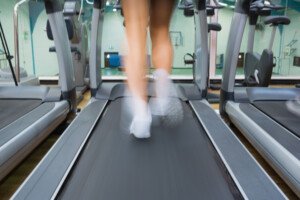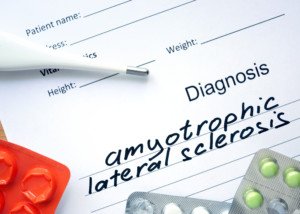Do you have twitching muscles? Does muscle twitching scare you into thinking you might have ALS or multiple sclerosis?
After all, muscle twitching can be a symptom of ALS, but save the panic attack because in ALS, muscle twitching is also accompanied by muscle weakness.
And by muscle weakness, I do not mean struggling to hoist a heavy garbage bag; or muscle weakness in that the left arm is sagging a bit while you are struggling with that grueling chest exercise or arm exercises. As a former personal trainer, I’ve seen this all the time.
Muscle twitching is a common result of strenuous exercise and weightlifting routines that leave muscles fatigued afterwards.

Shutterstock/Syda Productions
“Above all, fatigue is the reason for the muscle twitching,” explains Dr. Kevin Plancher, MD, a leading sports orthopaedist and sports medicine expert from the New York metropolitan area.
He says that “erratic firing of the muscles” can result from them being overworked.
In addition, says Dr. Plancher, lactic acid buildup can “alter the way muscles contract as well, possibly causing twitching.”
To think that twitching muscles might mean a neurological disease is like thinking that a little gas means you have stomach cancer. Exercise is a leading cause of muscle twitching.
The fancy name for muscle twitching, in the absence of clinical weakness, is benign fasciculations. Fasciculation means muscle twitching.
Intense aerobic exercise has a tendency to cause muscle twitching or benign fasciculations — once the aerobic exercise is over and you have taken up a restful position, such as in front of the computer.

Shutterstock/wavebreakmedia
You may find a lot of muscle twitching going on in your legs, calves and arches of your feet.
I’ve found that my twitchiest moments (legs) occur after trail running and power hiking.
Heavy leg pressing has been known to make my calf muscles twitch — between sets.
Heavy weightlifting exercises, as opposed to lighter weightlifting exercises, are more likely to make muscles twitch.

Shutterstock/Lyashenko Egor
Bench presses, pull-ups and intense triceps routines may trigger twitching muscles as well.
Muscle twitching following strenuous exercise is perfectly normal.
In fact, rather than let the twitching muscles induce fear that you have a deadly disease, remind yourself that muscle twitching means you conducted a rigorous workout — and that’s the way workouts should be: rigorous.
So what really makes muscles twitch, once you are in a resting state following the exercise?
Lactic acid buildup comes to mind. “Movement is a very good way to minimize the twitching,” says Dr. Plancher.
This is because movement, as opposed to rest, “helps the body move the excess lactic acid out of the muscles. It allows the electrolyte levels in the muscles to normalize if they are unbalanced due to fatigue of the nervous system,” continues Dr. Plancher.
Motion, then, “sloshes around” the lactic acid. While inert at your computer following an exercise session, you experience the twitching, but the moment you get up and walk across the room, the twitching stops.
Or, it will usually stop just from moving your legs about while you remain seated.
Another cause is that the motor neurons are still “excited” or innervated from the exercise, and they need some time to calm down.
Random electro-chemical impulses are firing away, causing the muscles to twitch. If anything, this means your muscles are in fine working order.
 Dr. Plancher is founder of Plancher Orthopaedics & Sports Medicine, and lectures globally on issues related to orthopedic procedures and sports injury management.
Dr. Plancher is founder of Plancher Orthopaedics & Sports Medicine, and lectures globally on issues related to orthopedic procedures and sports injury management.
 Lorra Garrick has been covering medical, fitness and cybersecurity topics for many years, having written thousands of articles for print magazines and websites, including as a ghostwriter. She’s also a former ACE-certified personal trainer.
Lorra Garrick has been covering medical, fitness and cybersecurity topics for many years, having written thousands of articles for print magazines and websites, including as a ghostwriter. She’s also a former ACE-certified personal trainer.
.










































